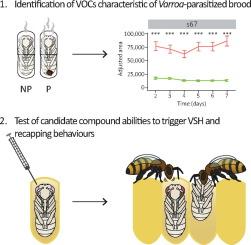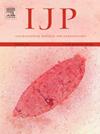Identification of five volatile organic compounds that trigger hygienic and recapping behaviours in the honey bee (Apis mellifera)
IF 3.2
2区 医学
Q1 PARASITOLOGY
引用次数: 0
Abstract
Varroa destructor, the main parasite of the honey bee (Apis mellifera), is having a devastating effect on beekeeping worldwide. The development of resistance traits in some colonies, linked with Varroa-sensitive hygiene (VSH) and recapping (REC) behaviours, provide an ideal avenue for long-term sustainable control of the parasite. The most important step in these behaviours is the detection of parasitized brood cells. Several semiochemicals released from Varroa-infested brood cells, targeted by VSH behaviour, trigger this behaviour. Most of these compounds are not very volatile. In the current work, we focus on the study of volatile organic compound (VOC) emissions from Varroa-infested cells. This study describes the emission of nine VOCs characteristic of Varroa parasitism, of which five could be identified and triggered hygienic and recapping behaviours. These five compounds were also tested with compounds already described in the literature, in relation to the volatile nature of the compounds. Using solutions containing 1–15 compounds, we looked at the cleaning and recapping behaviours of the workers. Behavioural results highlight the importance of the VOCs found in this study in the detection, opening and recapping of brood cells, while low volatile compounds seem to play a particularly key role in the sacrifice of pupae. Similar to the Varroa parasitization-specific (VPS) compounds, including the tetracosyl acetate alone, the cleaning of brood cells triggered by one of the compounds identified in this study, n-tetradecane, appears to be linked to the colony’s ability to carry out VSH behaviour. This study opens new perspectives in the understanding of resistance behaviour of honey bees against their main parasite Varroa destructor.

鉴定五种挥发性有机化合物,触发蜜蜂(Apis mellifera)的卫生和重盖行为。
蜜蜂(Apis mellifera)的主要寄生虫瓦螨(Varroa destructor)对全世界的养蜂业造成了毁灭性的影响。在一些种群中,抗性性状的发展与varroa敏感卫生(VSH)和重盖(REC)行为有关,为长期可持续控制该寄生虫提供了理想的途径。这些行为中最重要的一步是检测被寄生的育巢细胞。从被瓦罗亚虫感染的卵巢细胞中释放的几种半化学物质,被VSH行为靶向,触发这种行为。这些化合物大多不容易挥发。在目前的工作中,我们重点研究了瓦螨侵染细胞的挥发性有机化合物(VOC)排放。本研究描述了Varroa寄生的9种挥发性有机化合物的特征,其中5种可被识别并引发卫生和重盖行为。这五种化合物也与文献中已经描述的化合物进行了测试,与化合物的挥发性有关。使用含有1 - 15种化合物的溶液,我们观察了工人的清洁和重盖行为。行为学结果强调了本研究中发现的挥发性有机化合物在孵化细胞的检测、打开和重新包装中的重要性,而低挥发性化合物似乎在蛹的牺牲中起着特别关键的作用。与Varroa寄生特异性(VPS)化合物(包括单独的乙酸四酯)类似,本研究中发现的一种化合物(n-十四烷)引发的孵化细胞清洗似乎与蜂群执行VSH行为的能力有关。本研究为了解蜜蜂对其主要寄生虫瓦螨的抗性行为开辟了新的视角。
本文章由计算机程序翻译,如有差异,请以英文原文为准。
求助全文
约1分钟内获得全文
求助全文
来源期刊
CiteScore
8.40
自引率
2.50%
发文量
76
审稿时长
23 days
期刊介绍:
International Journal for Parasitology offers authors the option to sponsor nonsubscriber access to their articles on Elsevier electronic publishing platforms. For more information please view our Sponsored Articles page. The International Journal for Parasitology publishes the results of original research in all aspects of basic and applied parasitology, including all the fields covered by its Specialist Editors, and ranging from parasites and host-parasite relationships of intrinsic biological interest to those of social and economic importance in human and veterinary medicine and agriculture.

 求助内容:
求助内容: 应助结果提醒方式:
应助结果提醒方式:


